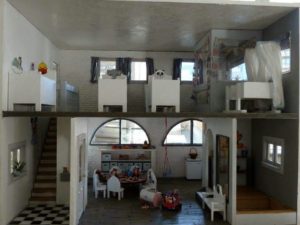Readers, welcome to part 2 of my interview with Juradaa, Herald of Communications for the people of the Tai-ii-katch system of worlds. Herald Juradaa is speaking to us from a space station orbiting planet 9-6. Last week we focused on life aboard the Tai-ii-katch space colonies. This week, we delve a little more into their family life.
S: Herald Juradaa, can you tell me a little more about family life in your colony?
J: Family is not a common term among my people—I’m looking at the translation. Ah, I believe I understand. We do not live in family units as you do. We have two sexes, male and female. Males and females mate when and with whom they please. If no children are desired at a particular time, we have effective means of reproduction control. Such is necessary to prevent overpopulation. Each female has a quota of young that she is allowed to birth. Our children are raised communally in kintales. Their quarters are similar to the adult quarters, although the youngest children  share a sleeping area. Each pod has a recreation and eating area, and an adult lives in each pod with them. The children also have communal activities with children from other pods.
share a sleeping area. Each pod has a recreation and eating area, and an adult lives in each pod with them. The children also have communal activities with children from other pods.
S: Are the children also educated in the kintales?
J: For the first ten years, then they are tested for the specialties they will pursue. Depending on the type of job they qualify for, they receive another two to ten years of schooling.
S: What percentage would you say need the least schooling, and what types of jobs do they do?
J: About half require two years of advanced schooling, and those jobs tend to be what you would identify mostly as service jobs. In many cases, those young people receive more of their training in the workplace. Those requiring the most schooling are those headed into research and technology development. Of course, as with any advanced society, there are a broad range of professions in between.
S: What do young nantrans do for fun?
J: There are times when it seems to me their favorite pass time is causing trouble, but they participate in simpler versions of many of the same sports as adults. The young males especially enjoy mock combat, though we have little use for that with our technology. It’s mostly a way to test each other’s strength.
young males especially enjoy mock combat, though we have little use for that with our technology. It’s mostly a way to test each other’s strength.
S: That seems rather dangerous.
J: Not as bad as it looks. The fire is designed not to damage the ship’s walls, but admittedly, some of their games can get out of hand. Our young people are intelligent, imaginative, and inventive, and our maintenance techs spend an inordinate amount of time repairing our youths’ games gone awry and their inventive experiments, some of which come dangerously close to sabotage.
S: What happens to the ones who misbehave?
J: They are reprimanded and lose privileges, usually lose the opportunity to compete in sports for a while. They are also required to assist in repairing what they have damaged, so they will understand it is not a harmless prank when it costs someone else time and labor. My preference is to require them to do the work by hand, without the aid of robots. It is not a popular lesson, but very effective.
S: You sound like you might have had a few of those lessons yourself.
J: Oh, of course. I once rerouted a wastewater conduit into a fountain near the station’s command deck. I spent a month on cleaning duty using only hand tools and a bucket. But that is part of youth, isn’t it—to do stupid things and learn the consequences? I believe the more intelligent the species, the more likely such pranks are. It seems to be an integral part of the developing self discipline.
S: I agree. Human children are prone to pranks as well. In my country, we even have a holiday devoted to that purpose. We call it Halloween. Children, and even adults, dress in costumes and go from door to door saying “trick or treat.” The implication is that if you don’t give them candy, they will play a trick on you. The most common one seems to be draping rolls of toilet paper, a very thin paper, over peoples’ trees. It can be extremely difficult to clean up after.
J: How are the children punished?
S: They aren’t usually punished for pranks during Halloween, as long as they don’t do any real damage. Most of them make a point of doing it in secret, though I suspect the victims have a good idea who the culprits are.
J: That sounds interesting. I’d like to learn more about that. Perhaps allowing one day for such activities would make it less of a problem the rest of the time.
S: It might be worth a try. In our case, it is also connected with some ancient religious beliefs as a time when spirits rise from the dead for one night. Few people see it that way any more. Now it’s mostly just for fun. Can you tell me about the practice of religion among your people?
J: We have no religion—we outgrew such nonsense long ago. We rely on science. I believe that at some point in our ancient past, our ancestors may have followed some religion, or perhaps even more than one. There are a few ancient stone ruins on our home planet that were excavated centuries ago. Historians may keep records of such things, but it holds no interest for me or most other nantrans.

S: Do your people keep any animals as pets?
J: Yes. I had a ginjee as a child. They are very affectionate, but also somewhat mischievous, so they provide good lessons for children in properly caring for them. They fly, and they’re very good at zipping out of open doors and windows if you don’t watch them. At one time, our home planet had a broad variety of species that have gone extinct, but have been cloned or re-bred in our space colonies. We also have a number of species from other planets, several of which children often keep as pets.
S: What is life like on the other planets you’ve colonized? Are some of them more livable?
J: Most are nothing more than sources of minerals, metals, and other resources for us. The workers there live in habitats similar to those on 1-4. This is a picture from 6-4 near one of our mining sites. Some of them do have beautiful geologic formations.
in habitats similar to those on 1-4. This is a picture from 6-4 near one of our mining sites. Some of them do have beautiful geologic formations.
S: So those other planets didn’t have any lifeforms on them?
J: Most did not. A couple had mostly microbial life and lower flora like mosses and algae. Most of the lower lifeforms have gone extinct over the centuries as the native habitats and atmosphere declined.
S: You didn’t make any effort to preserve the native species? I’d think that having destroyed your home planet, you’d be more inclined to protect the new ones you colonized?
J: For what purpose?
S: Just so they would continue to develop.
J: Once we have taken what we need from them, further development would serve no purpose. Most of the mineral resources are laid down in the early stages of a planet’s development, and lower life forms have no use for those. The plants and animals that we consume as food can be easily maintained in our planetary habitats and orbiting colonies.
S: But it seems—immoral, or at least unethical, to destroy the native life on a planet just to extract the resources you want to use.
J: Why would that be immoral? They are there for our taking. We are not waging war with anyone over them. It is no different on your planet. You have stripped out much of the natural mineral resources of your first planet, and now seek to mine others.
S: We are trying to preserve the resources and animal life of our planet, however. That is an ongoing battle, and I can’t say we’ve been very successful yet, but at least we are aware of the need to do that.
J: I can not see any point in wasting resources on such an effort, unless the ones you are trying to preserve are used for food, or provide other necessary elements.
 S: I gather then that none of the planets you colonized had native sentient species.
S: I gather then that none of the planets you colonized had native sentient species.
J: One had a sentient species of lower intelligence. Those have been trained as workers.
S: Isn’t that rather like enslaving them?
J: If you train an animal to work, to farm a field or to pull a vehicle, is it a slave? The sub-nantrans are well-cared for.
S: But, if allowed to evolve naturally, they might continue to develop as humans have.
J: More likely they would die out long before that stage. It would take a million years or more in the best case. We don’t intend to wait around. We will leave these planets behind in another five or six decades and move on to more lucrative ones. If the sub-nantrans do not choose to move with us, I suppose they will be left to their own devices on their native planets. I doubt many of them would choose to stay behind.
S: It doesn’t sound like the planets will be habitable by the time you get done with them.
J: Not without artificial habitats.
S: Well, Herald Juradaa, it’s time for me to draw this to a close. We’ve learned a great deal about your people. Thank you so much for talking with me.
J: Well. I’ve learned some interesting things about your people as well. Good life and prosperity to you.
S: Thank you. The same to you.
Readers, next week we’ll depart from the alien interviews for a while. I’ll be writing about science issues for science fiction writers. I’m no scientist, but I hope I can offer some information and links that will prove useful. If you have any ideas you’d like discussed, post a comment on the science for scifi thread on my author’s page at https://www.facebook.com/authorsusaneschbach/?ref=aymt_homepage_panel&eid=ARCFwI66spZ4vmAvKzgplo-CPfPBkqrjEesQ-S4fbOH_aAdNOPKG11s3gPxxpn0N0aK6MZ9GQvXaSpnk
